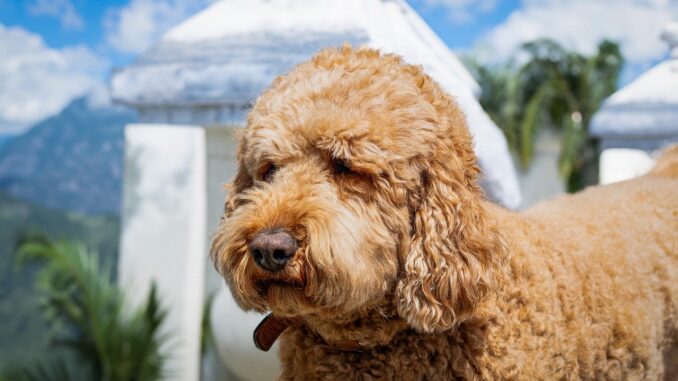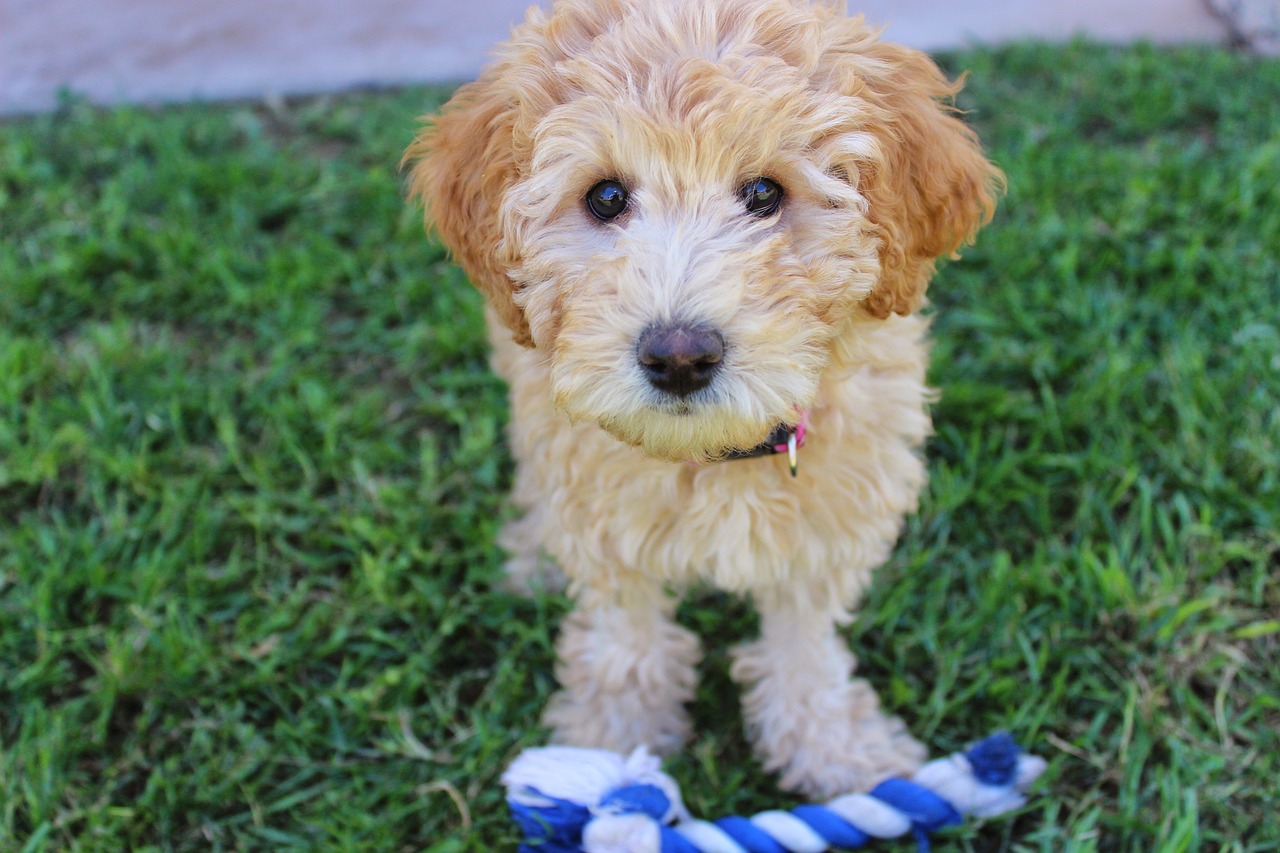
[ad_1]
Labradoodles, known for their intelligence, affectionate nature, and hypoallergenic coats, are a delightful blend of Labrador Retriever and Poodle. One aspect of their care that often gets overlooked is ear cleaning. These dogs inherit floppy ears from both parent breeds, creating a warm, moist environment ideal for bacteria and yeast growth. Regular ear cleaning is vital for preventing infections and maintaining overall ear health.
Unattended ears can lead to a variety of issues, including ear infections, which are uncomfortable and potentially painful for the dog. These infections can become chronic and lead to more serious complications, such as hearing loss. Additionally, the Labradoodle’s love for swimming and outdoor activities makes them more susceptible to ear problems, as water and debris easily become trapped in their ears. Cleaning their ears not only prevents these issues but also provides an opportunity to check for signs of infection, mites, or other concerns.
Step-by-Step Instructions for Cleaning a Labradoodle’s Ears:
- Gather Supplies: You will need a veterinarian-approved ear cleaning solution, cotton balls or gauze, and treats to reward your dog. Avoid using cotton swabs as they can damage the ear canal.
- Preparation: Choose a quiet, well-lit area where your dog feels comfortable. Gently pet and calm your dog before beginning.
- Examine the Ears: Before cleaning, check for signs of infection, such as redness, swelling, discharge, or a bad odor. If these are present, consult your veterinarian before proceeding.
- Apply Cleaning Solution: Fill the ear canal with the cleaning solution, but do not insert the applicator tip into the ear canal. Gently massage the base of the ear for about 30 seconds. You’ll hear a squishing sound as the product dislodges debris and buildup.
- Allow Your Dog to Shake: Step back and let your dog shake its head. This helps loosen and remove debris from the ear canal.
- Wipe Away Debris: Using a cotton ball or gauze, gently wipe out the ear canal, removing loosened debris. Never insert anything deep into the ear canal.
- Dry the Ears: Ensure the ears are dry after cleaning to prevent moisture buildup, which can lead to infections.
- Reward Your Dog: Always end the session with a treat and positive reinforcement to make it a pleasant experience for your pet.
Frequency of Cleaning: The frequency of ear cleaning depends on your Labradoodle’s lifestyle and ear health. Dogs that swim frequently or have a history of ear problems may need more frequent cleanings.
Benefits of Regular Ear Cleaning:
- Prevents Infections: Regular cleaning helps prevent the buildup of bacteria and yeast, reducing the risk of infections.
- Early Detection of Issues: Regular checks during cleaning can help in early detection of issues like mites, ticks, or other abnormalities.
- Reduces Odor: Cleaning helps in controlling ear odor.
- Comfort: Clean ears are more comfortable for your dog, reducing the likelihood of scratching and discomfort.
In summary, regular ear cleaning is an essential part of a Labradoodle’s grooming routine. It not only keeps their ears healthy but also provides an opportunity to bond with your pet. By incorporating ear cleaning into your regular grooming schedule, you are taking a proactive step in ensuring your Labradoodle’s overall well-being and comfort. Remember, if you ever notice anything unusual during cleaning, it’s always best to consult with your veterinarian.
Frequently Asked Questions About Cleaning A Labradoodle’s Ears
1. How often should I clean my Labradoodle’s ears?
The frequency of cleaning a Labradoodle’s ears depends on their lifestyle and susceptibility to ear problems. Typically, it’s recommended to clean their ears every 1-2 weeks. However, if your Labradoodle is more active outdoors or enjoys swimming, you might need to clean their ears more frequently, possibly weekly. For those with a history of ear infections or excessive wax production, a veterinarian might advise a specific cleaning schedule. It’s crucial to strike a balance – over-cleaning can irritate the ears, while under-cleaning can lead to infections. Monitoring your dog’s ears regularly for signs of dirt, wax buildup, or infection can help you determine the right cleaning frequency.
2. What is the best ear cleaning solution to use for a Labradoodle?
The best ear cleaning solution for a Labradoodle should be specifically designed for dogs and approved by veterinarians. Avoid using alcohol-based solutions or hydrogen peroxide, as these can irritate the sensitive skin inside the ears. Many pet stores sell dog-specific ear cleaning solutions that are gentle and effective. These solutions often contain ingredients to help break down wax, dry out excess moisture, and prevent the growth of bacteria and yeast. If your dog has a history of ear infections or sensitive skin, your veterinarian may recommend a specific brand or formulate a solution tailored to your dog’s needs.
3. Can I use water to clean my Labradoodle’s ears?
It’s not recommended to use plain water to clean your Labradoodle’s ears. Water alone does not effectively break down ear wax or debris, and it can leave moisture behind in the ear canal, potentially leading to infections. Instead, use a veterinarian-approved ear cleaning solution specifically designed for dogs. These solutions are formulated to safely clean the ear canal, help dissolve wax and debris, and often include drying agents to reduce moisture.
4. How can I tell if my Labradoodle has an ear infection?
To identify an ear infection in your Labradoodle, look for symptoms such as redness or swelling in the ear, a bad or unusual odor, discharge that may be yellow, brown, or bloody, and signs of discomfort like scratching, shaking the head, or whining. An ear infection may also cause your dog to hold their head to one side or seem off-balance. If you suspect an ear infection, it’s important to consult your veterinarian promptly for proper diagnosis and treatment.
5. What should I do if my dog resists having its ears cleaned?
If your Labradoodle resists ear cleaning, start by creating a positive and calm environment. Use treats and praise to associate ear cleaning with a positive experience. Gently acclimate your dog to having its ears touched and handled without cleaning at first. During cleaning sessions, be quick but gentle, and continuously reassure your dog. If resistance continues, consider seeking the assistance of a professional groomer or trainer for additional tips and techniques.
6. Can ear mites affect Labradoodles, and how would ear cleaning help?
Ear mites are a common issue in dogs, including Labradoodles. These tiny parasites cause intense itching, leading to scratching and shaking of the head. Regular ear cleaning can help in early detection of ear mites, as you might notice black or brown discharge resembling coffee grounds, which is a classic sign of ear mites. Cleaning also helps remove some of the mites and their debris. However, if you suspect ear mites, consult your veterinarian for appropriate treatment, as over-the-counter products may not be effective.
7. How deep should I clean my Labradoodle’s ears?
When cleaning your Labradoodle’s ears, it’s important not to insert anything deep into the ear canal, as this can cause injury. Clean only the parts of the ear you can easily see. Use a cotton ball or gauze pad soaked in a vet-approved ear cleaner to gently wipe the inside of the ear flap and the accessible part of the ear canal. Avoid using cotton swabs, as they can push debris deeper into the ear or damage the delicate structures inside the ear.
8. Is it normal for my Labradoodle to shake its head after ear cleaning?
Yes, it’s normal for your Labradoodle to shake its head after ear cleaning. This is a natural response to the sensation of the cleaning solution in the ear canal and helps to dislodge and remove debris. Give your dog the opportunity to shake its head after applying the cleaning solution, but be prepared for a little mess if the solution is flung out!
9. What are the signs of excessive ear wax in Labradoodles, and how does cleaning help?
Signs of excessive ear wax in Labradoodles include visible buildup of dark wax, frequent shaking of the head, scratching at the ears, and a strong, unpleasant odor. Regular ear cleaning helps remove excess wax, preventing blockages and maintaining good ear health. If excessive wax is a consistent issue, consult your veterinarian for advice and possible underlying causes.
10. Can regular ear cleaning prevent ear infections in Labradoodles?
Yes, regular ear cleaning can significantly reduce the risk of ear infections in Labradoodles. By routinely removing dirt, debris, and excess wax, you create an environment less hospitable to bacteria and yeast, which are common causes of ear infections. However, it’s also important not to over-clean, as this can irritate the ears and disrupt their natural balance.
11. Should I clean my Labradoodle’s ears after swimming?
Yes, it’s a good practice to clean your Labradoodle’s ears after swimming. Water can get trapped in the ear canal, especially in dogs with floppy ears like Labradoodles, creating a breeding ground for bacteria and yeast. Use a veterinarian-approved ear cleaner to gently clean and dry the ears after swimming to prevent infections.
12. How can I dry my Labradoodle’s ears effectively after cleaning?
After cleaning your Labradoodle’s ears, it’s important to dry them thoroughly to prevent moisture buildup. Gently wipe the inside of the ear flap and the accessible part of the ear canal with a dry cotton ball or gauze pad. Avoid using cotton swabs. If your dog’s ears are particularly prone to moisture, your vet may recommend a special drying solution or technique.
13. What precautions should I take while cleaning my Labradoodle’s ears?
When cleaning your Labradoodle’s ears, take precautions to ensure safety and comfort. Never insert anything deep into the ear canal, as this can cause injury. Use only veterinarian-approved ear cleaning solutions, and avoid harsh substances like alcohol or hydrogen peroxide. Be gentle and patient, and stop immediately if your dog shows signs of pain or distress. If you notice any signs of infection or abnormality, consult your vet before continuing with routine cleaning.
14. Can diet affect my Labradoodle’s ear health?
Yes, diet can impact your Labradoodle’s ear health. Allergies or sensitivities to certain foods can manifest as ear problems, including increased wax production or infections. Feeding a well-balanced diet that suits your dog’s specific needs can help maintain overall health, including ear health. If you suspect food allergies or sensitivities, consult your veterinarian for dietary advice and possible allergy testing.
15. How do I know if I’m cleaning my Labradoodle’s ears correctly?
To ensure you’re cleaning your Labradoodle’s ears correctly, follow veterinarian-approved guidelines and techniques. After cleaning, the ears should not be red or irritated, and your dog should not show signs of discomfort. If you’re unsure about your technique or if your dog’s ears seem to be getting worse, consult your veterinarian or a professional groomer for guidance and advice. Regular vet check-ups can also help confirm that your ear-cleaning routine is effective.
[ad_2]
Source link


Leave a Reply